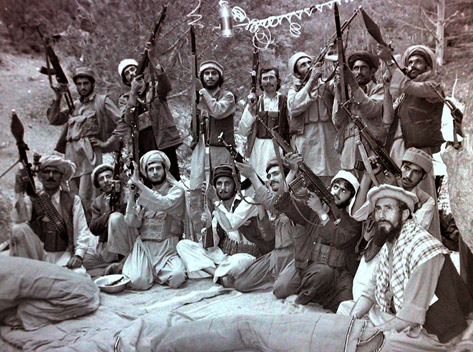Soviet Union (target: Afghanistan) 1979-91

Mujahedin in 1984
From the U.S. perspective, the anti-Soviet war in Afghanistan began in 1978, when a coup d'état brought a communist regime to power in Kabul. Over the next year, armed resistance grew, a trend which triggered approaches to the CIA by Pakistan and Saudi Arabia. Plans began to be drawn up for reversing “the current Soviet trend and presence in Afghanistan,” and in the summer of 1979, Carter approved covert aid to mujahedin guerrillas. Although this aid did not include arms, it provided nonmilitary supplies and cash with which weapons could be purchased. Six months later, the Soviets sent troops into Afghanistan, a move which immediately led Carter's National Security Adviser to advocate “more money as well as arms shipments to the rebels,” both directly and via Pakistan, China, and Islamic countries. For the next decade, the CIA aided the guerrillas, at first with weapons purchased from China, Egypt, and Pakistan, then with increasingly sophisticated U.S. arms (including Stinger missiles, shipped to the mujahedin at the same time as to UNITA). All told, U.S. aid in arms and cash totaled some $2 billion. Up through the late 1980s, American assistance was supplied through the Pakistani intelligence service (ISI), which also provided training; except on rare occasions, the CIA did not deal directly with the rebels. In addition, Saudi Arabia contributed significant sums of money to the resistance until, by the end of the 1980s, its financial role was greater than that of the U.S.
Eventually, the Soviet Union decided to withdraw its troops from Afghanistan. Early on in the negotiations, Washington had been willing to end its aid to the guerrillas in exchange for Soviet withdrawal. This concession was retracted at more or less the last minute, meaning that the Soviet-supplied regime in Kabul would continue to fight against U.S.-supplied guerrillas. However, things did not go as the CIA had planned. The Kabul government held out for several years, repulsing one after another CIA- and ISI-planned offensives. The U.S. had helped the ISI set up urban sabotage training for the mujahedin, and after the Soviets left, these techniques began to be used by the largest guerrilla movement against its rivals; that army also carried out indiscriminate rocket attacks that led to numerous civilian casualties; it was active in the heroin trade; and it espoused a brand of Islamic fundamentalism that led it to oppose the U.S. and the Saudis in the 1991 Gulf War. These factors, plus the fact that the Soviets had withdrawn their combat forces, made it increasingly difficult for the U.S. to sustain its policy. Already, even before the last Soviet troops had left, a State Department envoy was describing “a growing frustration, bordering on hostility, among Afghans across the ideological spectrum and from a broad range of backgrounds, toward the government of Pakistan and toward the U.S.” because of the extremist forces they were backing. Congress, after years of enthusiastically increasing the CIA's Afghan funds, began to cut the budget and demand that aid be channeled to less repulsive allies. Aid to Pakistan was also cut (in part because of concerns over its nuclear weapons), as was the Saudi contribution because of anger over the Gulf War. The U.S. announced that the Kabul government could stay in place during a transition and even participate in elections. Finally, in 1991, the U.S. and the Soviet Union agreed on a plan in which both sides would end their arms deliveries and bring the UN into a political settlement; in spite of the CIA's objections, Washington terminated its support for the resistance. The next year, the Kabul regime disintegrated and the guerrillas, joined by some of the former communists, took power and faced off against each other in a new civil war. 1
1) Newsom, statement in meeting of 30 March 1979, paraphrased in Gates (1996: 144); Brzezinski to Carter, “Reflections on Soviet Intervention in Afghanistan,” 26 December 1979 (CNN 1998: ep. 20); McWilliams to State, “ISI, Gulbuddin and Afghan Self-Determination,” mid-October 1988, quoted in Coll (2004: 183); also “Afghans: Now They Blame America,” New York Times Magazine , 4 February 1990; Cogan (1993); Rubin (1995a, 1995b); Cordovez and Harrison (1995); Scott (1996: ch. 3); McCoy (2003: ch. 9); Crile (2003). Note that the initial contacts between the mujahedin and the CIA date to 1978 (Schroen 2005: 43-4); note also that there is considerable controversy about whether, and if so how much, the Stinger missiles contributed to the Soviet decision to withdraw.
